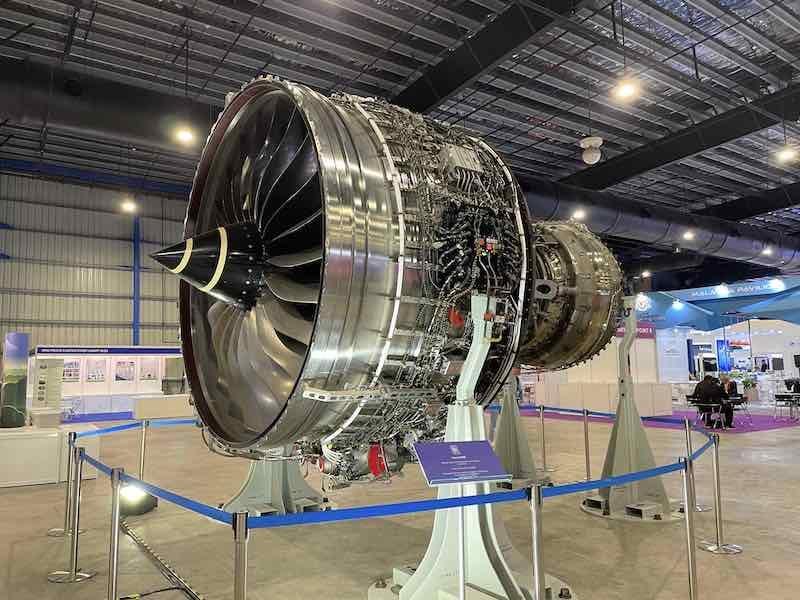
The Trent XWB, on display here at Singapore Airshow, is one of the engines that Rolls-Royce is working to upgrade.
SINGAPORE—Rolls-Royce has unveiled new details of a broad upgrade effort for its Trent 1000, 7000 and XWB engine family aimed at significantly improving durability and bolstering its longer term market position in the widebody sector on the Airbus A330neo, A350 and Boeing 787 programs.
The move follows comments made in November by Rolls-Royce CEO Tufan Erginbilgic that the company planned to plow more than £1 billion ($1.25 billion) into the product line which exclusively powers the A330neo and A350, and in the case of the Trent 1000, competes with GE Aerospace’s GEnx-1B on the 787.
The investment forms a key part of the engine-maker’s new strategic vision which targets a four-fold increase in annual operating profits to $3.5 billion by 2027 and aims to boost operating margins from around 5% to 14%—levels never previously achieved by the manufacturer. It also comes in the wake of huge losses associated with the slump in long-haul traffic during COVID and the development of expensive fixes to the durability issues that have plagued the Trent 1000, particularly since 2016.
“We're no longer talking about fixes. This is talking about making a world class engine family even better and better,” says Ewen McDonald, chief customer officer at Rolls-Royce Civil Aerospace. “So that is the Trent 7000, 1000 and the two Trent XWBs,” he says referring to the XWB-84-powered A350-900 and XWB-97-powered A350-1000. “We're making improvements to all of those. How can we do that? We have all our technology demonstrator programs, including UltraFan, and we're taking some of those technologies and putting them back in.”
Although more specific details have not yet been announced, the overall upgrade effort includes new materials, coatings and turbine-cooling systems. For the Trent 7000, the upgrades build on a durability enhancement that entered service on the A330neo in 2022. “We're seeing that improvement turn up,” says McDonald, who adds that borescope inspections “have looked really encouraging that we will achieve more than a doubling of time on wing."
"What we're doing now in the Trent 7000 is we've got another program which will come out in 2026 which will improve time on wing by a further 30%," he says.
On the Trent 1000 TEN variant, the sister engine of the Trent 7000, the same upgrade package is undergoing final flight tests with Boeing on a development 787. The new turbine blade design, which boosts cooling airflow by 40% and increases blade life by reducing sustained operating temperatures by 45F, forms part of a company plan to double time-on-wing to higher levels.
“It’s been long delayed for a number of reasons but will come in later this year,” McDonald says. “But the enhancement of a further 30% will come in 2026, so that's coming fast behind. It shows our commitment to the 787 and we will be looking to win new customers and retain existing customers."
Obliquely referencing some former Trent 1000 operators—like LATAM Airlines and Thai Airways which have switched to GE for new 787 orders—McDonald says: “You win some, you lose some. The market is up and down. I've been in the business for many years. I don’t react to things that happen in five minutes, I react to what can we do over the next 10-20 years.”
For the Trent XWB-84 on the A350-900, McDonald says: “We're looking at aerodynamic upgrades which will deliver a 1% improvement in fuel burn that will be coming into service in 2025. We've done it by stealth—these things don't happen that quickly. We've been working on this for a number of years and we're now at the point that we've done flight testing and bench testing of this engine and we're feeling very confident."
The upgrade package will be available for new-build engines from 2025. “Through this we’re also improving the time-on-wing so the turbines actually run cooler as well. The airline gets a benefit the fuel burn and gets a benefit of that reduced carbon footprint as well as more payload,” he notes.
Upgrades are also planned for the higher thrust XWB-97, which received criticism at the recent Dubai Airshow from Emirates President Tim Clark who effectively ruled out an order for Airbus A350-1000s if Rolls-Royce does not come up with major improvements. “This is a staged program based on a series of technology insertions coming into the engine going out to 2028,” McDonald says.
“In the end, by 2028, versus today, in the harshest of conditions we're going to double time-on-wing through these technology insertions and on the normal benign operations we will improve it by 50%. So today, we really don't have a problem on benign operations, but we want to get ahead and stay ahead because what the airlines want is durability.”
Without directly referencing the potential Emirates order, McDonald adds that the upgraded XWB-97 will also be a great engine for carriers in the Middle East.
"We're talking to those airlines about what we're doing and if they want margin in then technology can do two things—you put technology in and make the engine more efficient, or you can use that technology to put more margin into the engine—and that's what we're doing. There'll be a slight improvement in the efficiency of the -97, but we just want to make sure it's the most robust engine that is out there," McDonald says.





